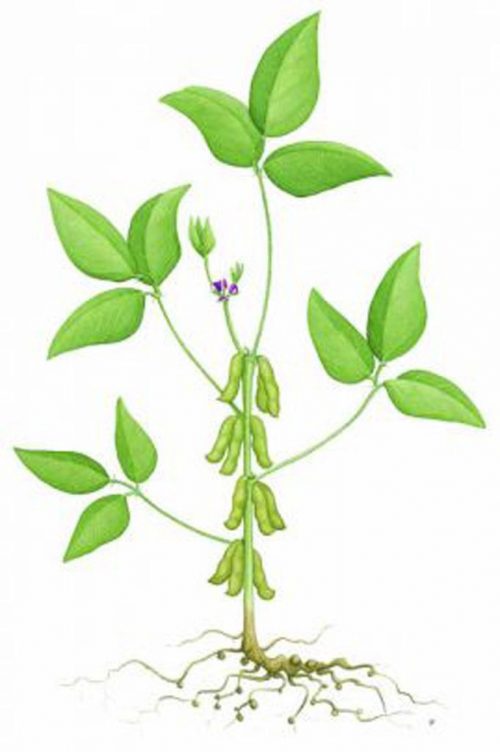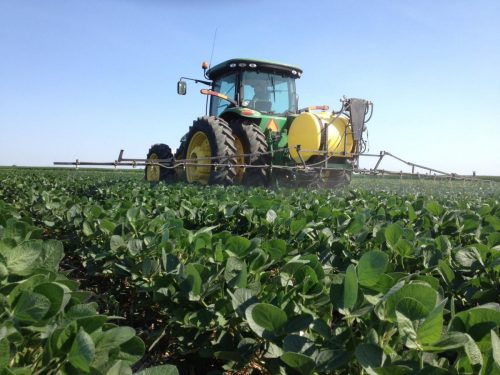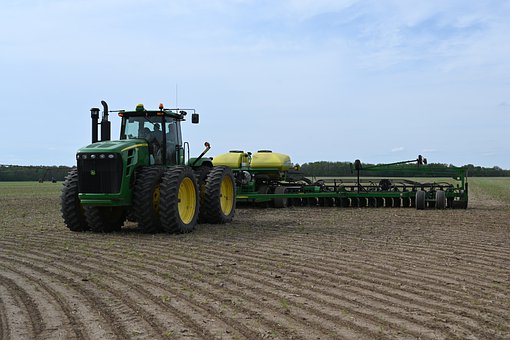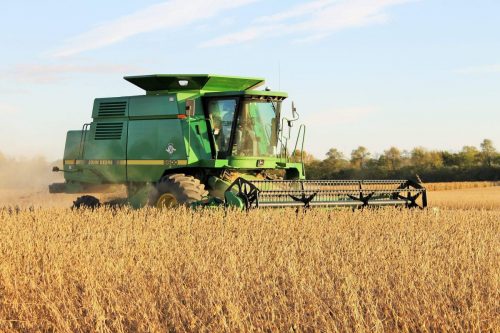Soybean, cultivation and harvesting technology
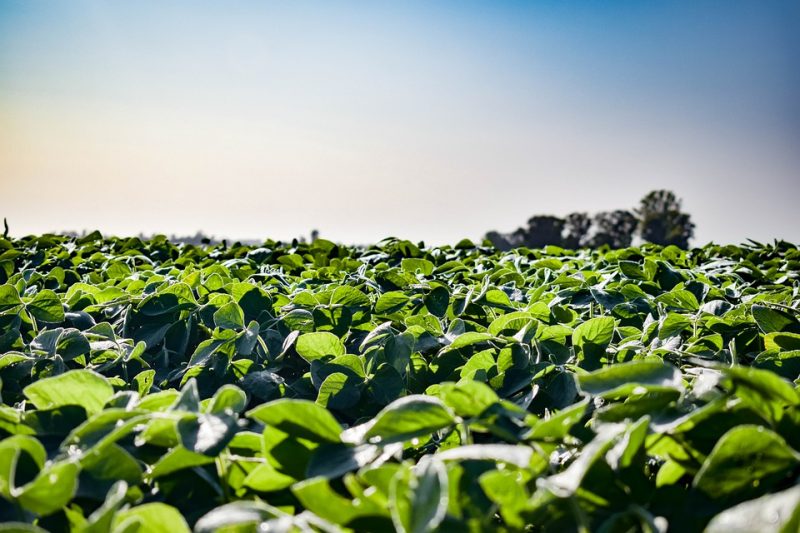
Soybean (Glycine max) is an oil- and protein-rich plant cultivated for its seeds, abounding in protein (27-50%) and fat (17-27%). The plant is used in human nutrition, in obtaining compound feed, for flour production, for fat extraction, or in the production of milk, sauces, or soups. The characteristic protein of soy is glycine. It is easily digestible and very similar to animal protein. Soybean fats are palmitin, stearin, olein, linolein, phytosterols, cholesterol, and lecithin. Soybean oil contains 75-85% unsaturated fatty acids.
It has a pivot root that penetrates the soil to a depth of 2 meters. The stem is covered with hairs, it is straight and branched. The leaves from the first node come from the cotyledons. Those from the second node are simple and unifoliate, and those located at the next nodes are alternately arranged, and trifoliate with a long petiole. The leaflets are oval, lanceolate, or rhombic. The flowers are represented by racemose inflorescences, arranged axially or terminally. The flowers are hermaphroditic, colored white or purple. The fruit is a curved pod with 1-5 seeds.
The soybean’s vegetation cycle consists of three stages:
- the vegetative growth stage: lasts 30-40 days;
- the reproductive stage: lasts 35-50 days;
- the seed maturation stage: lasts 30-50 days;
Environmental and soil requirements
The minimum germination temperature is 7 °C. After sprouting, daytime temperatures should be between 20 and 30 °C, and during the night they should not fall below 14 °C. Water requirements are high. The critical periods in terms of water requirements are registered in the stage in which the reproductive organs develop, during flowering and seed development. Insufficient water during these periods can reduce production by half. Soybean makes good use of intense light. Soils in which soybeans are grown must be well-drained, and rich in humus and nutrients (phosphorus, potassium, etc.).
Soybean crop technology
Crop rotation
Soybean is not a pretentious plant. However, it prefers precursors that leave a large amount of water in the soil. The best results are obtained after straw cereals and fodder crops, and in wet areas, it can be sown after sugar beet, corn, or potatoes. As precursor plants, are not recommended annual or perennial legumes, sunflower, or rapeseed. Soybean is a good precursor to most legumes.
Fertilization
Soybean is a major consumer of nutrients. The plants’ supply with nitrogen is done in two ways: through nitrogen absorption from the soil and nitrogen-fixing bacteria. The nitrogen is fixed in the stem and leaves until the development of the pods and then it is translocated into the seeds. Phosphorus promotes the development of nitrogen-fixing bacteria and contributes to the increase in the number of nodules. Potassium plays an important role in the synthesis of fats and their sedimentation in seeds. Basic fertilization can be done with complex NPK-type fertilizers, while ammonium sulfate can be applied to ensure the sulfur dose. Soybean also responds positively to foliar fertilizer application.
Recommended products
-
You can find products on a different store
Change Store -
You can find products on a different store
Change Store -
You can find products on a different store
Change Store -
You can find products on a different store
Change Store -
You can find products on a different store
Change Store -
You can find products on a different store
Change Store -
You can find products on a different store
Change Store -
You can find products on a different store
Change Store -
You can find products on a different store
Change Store -
You can find products on a different store
Change Store -
You can find products on a different store
Change Store -
You can find products on a different store
Change Store -
You can find products on a different store
Change Store -
You can find products on a different store
Change Store -
You can find products on a different store
Change Store -
You can find products on a different store
Change Store -
You can find products on a different store
Change Store -
You can find products on a different store
Change Store -
You can find products on a different store
Change Store -
You can find products on a different store
Change Store -
You can find products on a different store
Change Store -
You can find products on a different store
Change Store -
You can find products on a different store
Change Store -
You can find products on a different store
Change Store
Field works
Soybean prefer well-loosened, aerated soil, with no plant remains on the surface and no weeds. Fertilizers must be incorporated into the soil and the seedbed must be of good quality. The plowing depth should be 25-28 cm. This operation must be carried out immediately after removing the previous crop from the land. If plowing cannot be done in optimal conditions, work with a disc harrow should be performed at a depth of 7-11 cm. The seedbed has to be prepared in two stages. In the first phase, the work aims to destroy the crust, remove weeds and level the soil. After a few weeks, grinding and leveling work will be carried out with combined aggregates. The working depth of the combine must not exceed 5 cm.
Seeds and sowing
The seeds must be at least 98% pure and the germination must be at least 80%. The sowing period is established depending on the soil temperature (minimum 7-8 °C in the soil and 14-15 °C in the air). The sowing density is 50-55 germinating seeds per square meter. The sowing depth should not exceed 5 cm (2.5 -3.5 cm in the case of heavy soils). Sowing has to be done in strips of three rows at a distance of 45 cm between them. The distance between the strips must be between 60 and 70 cm.
Diseases and pests
The most important diseases that can occur in soybean crops are soybean mosaic virus, downy mildew, white rot, Septoria leaf spot, powdery mildew, pod, and stem blight of soybean. Among the pests, the most common are: mites, wireworms, bean seed fly, soybean cyst nematodes, pea leaf weevils, painted lady, and turnip moths.
Weed control
Proper agrotechnical measures can reduce the degree of weed infestation. Thus, the correct crop rotation, the correct soil preparation, and the sowing in the optimal periods have the effect of reducing the number of weeds in the crop. Herbicides can also be applied to control weeds, such as:
Recommended products
-
You can find products on a different store
Change Store -
You can find products on a different store
Change Store -
You can find products on a different store
Change Store -
You can find products on a different store
Change Store -
You can find products on a different store
Change Store -
You can find products on a different store
Change Store -
You can find products on a different store
Change Store -
You can find products on a different store
Change Store -
You can find products on a different store
Change Store -
You can find products on a different store
Change Store -
You can find products on a different store
Change Store -
You can find products on a different store
Change Store -
You can find products on a different store
Change Store -
You can find products on a different store
Change Store -
You can find products on a different store
Change Store -
You can find products on a different store
Change Store -
You can find products on a different store
Change Store -
You can find products on a different store
Change Store -
You can find products on a different store
Change Store -
You can find products on a different store
Change Store -
You can find products on a different store
Change Store -
You can find products on a different store
Change Store -
You can find products on a different store
Change Store -
You can find products on a different store
Change Store
Irrigation
It is very effective in areas with humidity deficits. Soybeans need water from the germination stage to fruit ripening. A lack of water can cause uneven sprouting or the flowers might fall prematurely. Watering should be done from the appearance of the first flowers until the development of the seeds. Generally, the crop should be watered 4 times at intervals of 10-14 days. Between 700-800 cubic meters/ha of water should be applied. During dry springs, the crop can be watered once, at sprouting (200-300 cubic meters/ha).
Harvesting
For an efficient harvest, the land must be leveled before sowing or at the same time with the field works. To reduce losses, varieties can be used (with pods that develop at the topside of the stem) and the optimal sowing density must be kept. The optimum time for sowing is determined visually when the leaves turn yellow and fall, and 70% of the pods are brown. During this stage, the seeds harden and have a humidity of 16%.














































































































































































































































































































































































































































